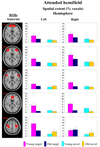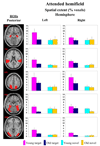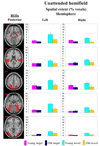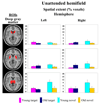Altered prefrontal function with aging: insights into age-associated performance decline
- PMID: 18691562
- PMCID: PMC2679978
- DOI: 10.1016/j.brainres.2008.07.060
Altered prefrontal function with aging: insights into age-associated performance decline
Abstract
We examined the effects of aging on visuo-spatial attention. Participants performed a bi-field visual selective attention task consisting of infrequent target and task-irrelevant novel stimuli randomly embedded among repeated standards in either attended or unattended visual fields. Blood oxygenation level dependent (BOLD) responses to the different classes of stimuli were measured using functional magnetic resonance imaging. The older group had slower reaction times to targets, and committed more false alarms but had comparable detection accuracy to young controls. Attended target and novel stimuli activated comparable widely distributed attention networks, including anterior and posterior association cortex, in both groups. The older group had reduced spatial extent of activation in several regions, including prefrontal, basal ganglia, and visual processing areas. In particular, the anterior cingulate and superior frontal gyrus showed more restricted activation in older compared with young adults across all attentional conditions and stimulus categories. The spatial extent of activations correlated with task performance in both age groups, but the regional pattern of association between hemodynamic responses and behavior differed between the groups. Whereas the young subjects relied on posterior regions, the older subjects engaged frontal areas. The results indicate that aging alters the functioning of neural networks subserving visual attention, and that these changes are related to cognitive performance.
Figures







References
-
- Alexander MP, Stuss DT, Picton T, Shallice T, Gillingham S. Regional frontal injuries cause distinct impairments in cognitive control. Neurology. 2007;68(18):1515–1523. - PubMed
-
- Ardekani BA, Choi SJ, Hossein-Zadeh GA, Porjesz B, Tanabe JL, Lim KO, Bilder R, Helpern JA, Begleiter H. Functional magnetic resonance imaging of brain activity in the visual oddball task. Brain Res. Cogn. Brain Res. 2002;14(3):347–356. - PubMed
-
- Aron AR, Robbins TW, Poldrack RA. Inhibition and the right inferior frontal cortex. Trends Cogn. Sci. 2004;8(4):170–177. - PubMed
-
- Banich MT, Milham MP, Atchley R, Cohen NJ, Webb A, Wszalek T, Kramer AF, Liang ZP, Wright A, Shenker J, Magin R. fMRI studies of Stroop tasks reveal unique roles of anterior and posterior brain systems in attentional selection. J. Cogn. Neurosci. 2000;12(6):988–1000. - PubMed
-
- Barcelo F, Suwazono S, Knight RT. Prefrontal modulation of visual processing in humans. Nat. Neurosci. 2000;3(4):399–403. - PubMed
Publication types
MeSH terms
Grants and funding
LinkOut - more resources
Full Text Sources
Other Literature Sources
Medical

